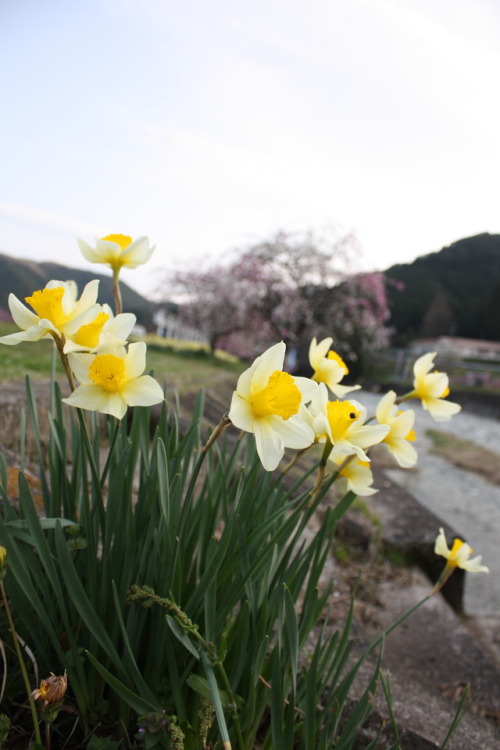#奥三河
Various gods, some are from myth of Japan(古事記Kojiki)
神話世界の神々、河内の花祭りにて

Kochi’s Hanamatsuri has two layers. The base layer is ordinary Hanamatsuri, and story derived from ‘Kojiki’ is newer layer. In this festival most remarkable program is '大蛇退治OROCHI TAIJI’ (annihilating huge snake). Of course this is a famous story in Kojiki. A mythical hero 素戔嗚SUSANO defeated an evil huge snake having eight heads by his clever scheme.
Now Let’s look at festival yard. We can see a great oni, its name is SUSANO.
河内の花祭りは二重構造になっています。本来は普通の花祭りだったものに、記紀神話がか覆いかぶさってきていると言えば良いでしょうか。神話の内容を取り込んだものになっています。「大蛇退治」という演目では、登場する鬼はスサノオノミコトと呼ばれ、獅子が八岐大蛇(やまたのおろち)の代役を務めます。
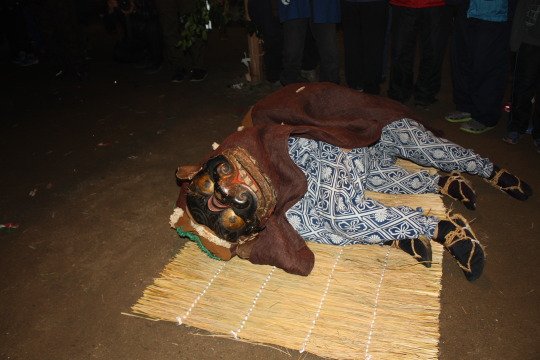
A Shishi(lion) entered the yard. But in this program it plays a role of huge snake called YAMATA NO OROCHI. By SUSANO’s scheme OROCHI had got drunk and lay down. SUSANO (oni) approached it and ,,,,
古事記にある通り、八岐大蛇(代 獅子)は酒に酔っぱらって地に伏します。そこへ、スサノオノミコトが近づいて
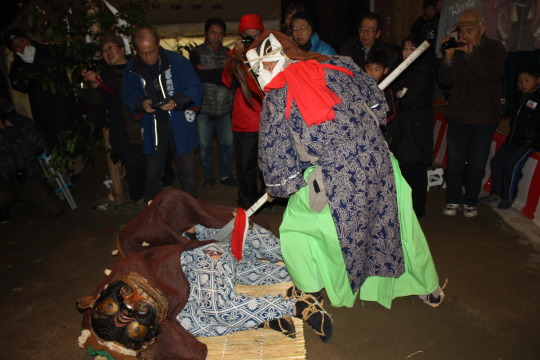
槍でグサッ。ひとしきりバトルがあり、スサノオノミコトは倒れ伏した獅子の体内から 天叢雲剣(あめのむらくものつるぎ)を取り出します。(獅子の後ろ足役の人が小剣を素戔嗚に手渡すのが、私の位置から見えました)
He stung Orochi with lance. The two fought for a while. But soon the god won. He took the sword from Orochi’s body. It is called AMANO MURAKUMO NO TSURUGI. (It is one of Three Sacred Treasures.This sword and other two treasures are things that prove their owner to be Japanese emperor, even today).

ほうほうの体で逃げたず八岐大蛇
At last Orochi escaped
Various gods, some are from myth of Japan(古事記Kojiki)
神話世界の神々、河内の花祭りにて

アメノウズメノミコトAMENOUZUMENOMIKOTO
Many villages in Shitara area have Hanamatsuri festival. Some of them are different from other usual Hanamatsuri in the aspect of having stories like a stage drama. The stories came from myth of Japan(古事記 Kojiki).
河内の花祭りは、記紀神話に由来する演目がいくつかあるというのが特色です。
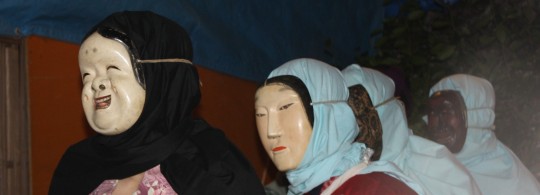
AMENOUZUME and her followers アメノウズメとその従者

翁 OKINA
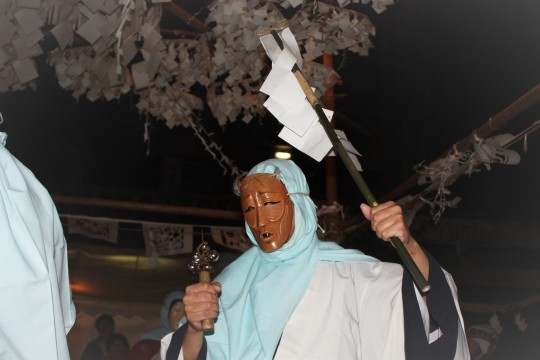
ひのねぎHINONEGI
Various gods, some are from myth of Japan(Kojiki)
神話世界の神々、河内の花祭りにて
Many villages in Shitara area have Hanamatsuri festival. Some of them are different from other usual Hanamatsuri in the aspect of having stories like a stage drama. The stories came from myth of Japan(古事記 Kojiki).
河内の花祭りは、記紀神話に由来する演目がいくつかあるというのが特色です。
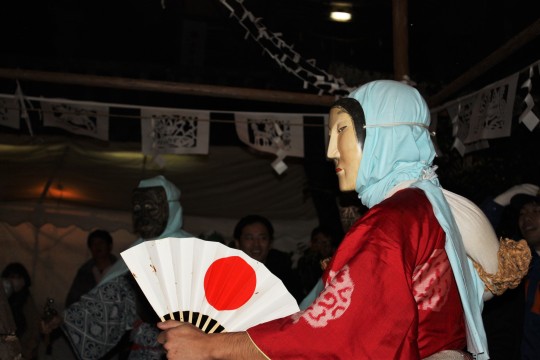

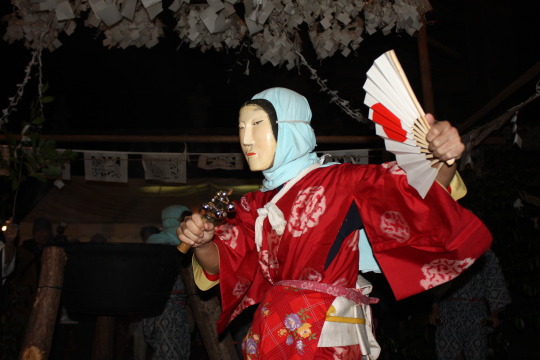
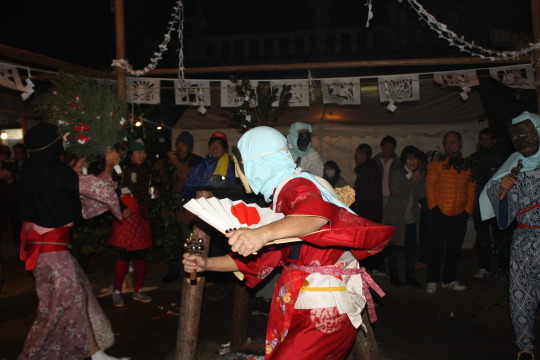
愛知県北設楽郡東栄町月の花祭り
A festival of winter solstice. Our ancestors believed their spirits got weaken at the season. So they held festival of water and fire in order to get new energy. This is also a festival of rebirth.
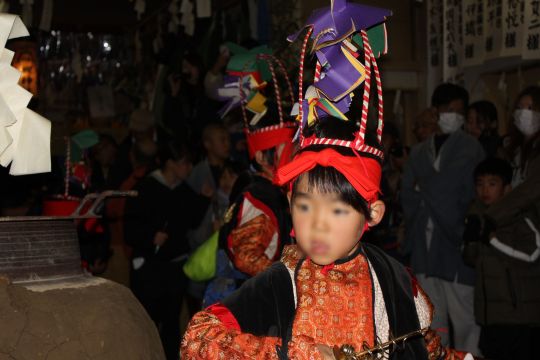



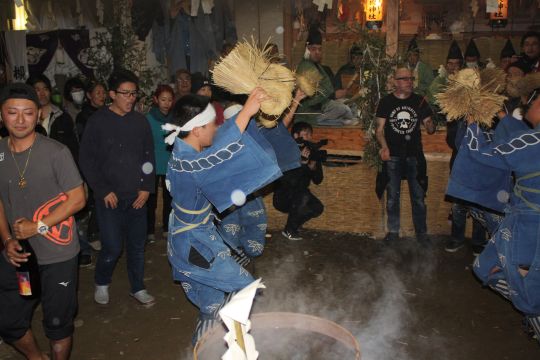
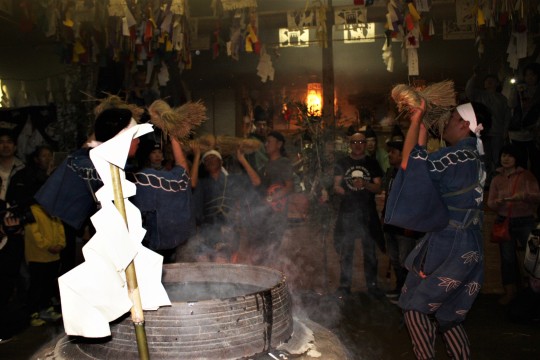
2019 東薗目の花祭
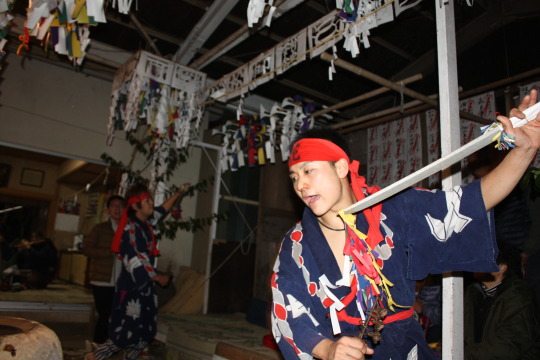

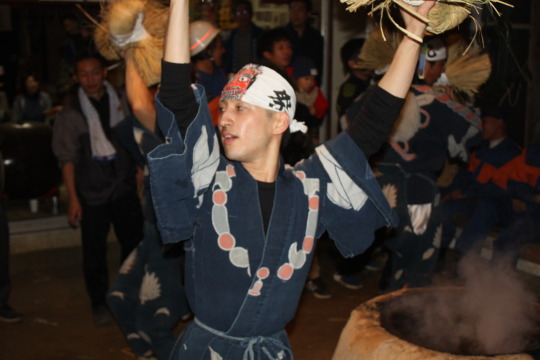

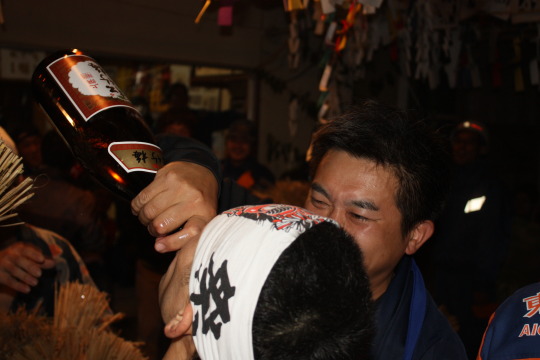
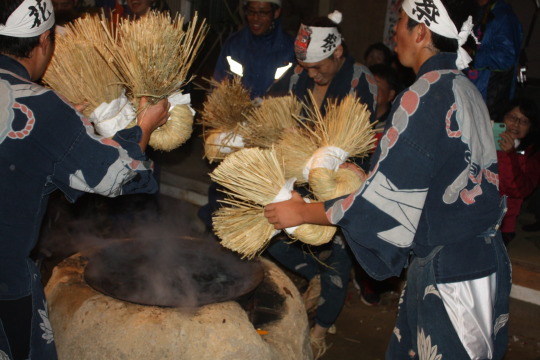
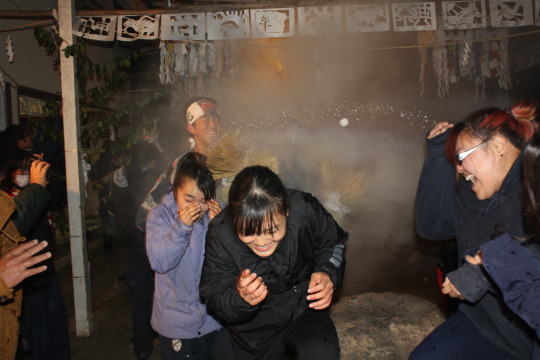
The festival of rebirth. They believe this holy hot water make their spirits vivid and their bodies healthy. 聖なる水と炎による生まれ清まりの祭り。冬至のころ、肉体と魂の再生を期して行われる湯立神楽です。
A novel, of memorable liquor store and logging railroad 17

Kurijima River at typhoon 2018 2018年の台風時の栗島川
「ここにいては危険だ。少しでも高いところに逃げよう。津島神社が良い」 正之さんは言った。
車軸を流すがごとき大雨である。加えて、立っていられないほどの強風。そして停電。真っ暗闇の中、耳を聾するばかりの川の音がする。子供たち4人を抱えて、無事に神社までたどりつけるだろうか? 我が家からわずか80mのところにあるのだが。
「行こう」という正之さん。「はい」と、覚悟を決めたように、ちか子さんが応える。
一家の命の危機であった。夫婦には二男二女の子供があった。「守らねば、守らねば。この子らを守らねば。伊藤家を守っていかなければ」ちか子さんは思った。
Masayuki-san said ‘It’s very dangerous to stay here. Let’s get away to higher place as much as possible. Tsushima jinja shrine would be proper.’
It rained bitterly and wind blew so extremely. It kept everyone from standing firmly. Moreover the power had been down.
Chikako-san thought 'In the true darkness , are we able to take our four children to the shrine ? Even if it’s only eighty meters.’
'Let us go.’ Masayuki-san said.
'Oh yes, my hus’ Chikako-san answered with determination.
The matter was life of whole family. Chikako-san and Masayuki-san had two sons and two daughters.
Chikako-san thought 'I must keep, I must keep their life, and blood of Ito family ’

伊勢湾台風。昭和34年(1959)に東海地方を襲った日本史上最悪の台風である。最低気圧は894hPa、中心付近の最大風速は90m/sを記録した(アメリカ軍による観測値)。
6人はずぶぬれになりながら、這うようにして神社の石段を登り、社殿の軒下へと入った。神社のすぐ下に我が家があり、そのすぐ隣が栗島川であった。その川の方から、かすかに音が響いてくる。どどぉん、どどぉんという重低音で、それがだんだんと大きくなる。最初にその音に気付いたのは、まだ幼い次男だった。
「お母さん、あれは何の音」
「え?」
音は次第に大きくなる。そして数も増してくる。あちこちから響いてくる地底の巨人の足音。無数の巨人が行進をしているような、重たい響きだった。
「あれは…」
正之さんはそのあとの言葉を続けることができなかった。
川底の岩石が、大雨による水流に耐え切れず、重い腰を上げて転がり始めた音なのだ。転石は転石を呼び、川のいたるところで、大岩が動き始めているのだった。いくら山の中、川のほとりに住んでいても、生涯何度も経験しないような地響きだった。一家は押し黙って夜明けを待った。
「神様、お助けください」ちか子さんはそうつぶやいて社殿の軒を見上げた。
全国の犠牲者数5098名。甚大な被害の中で夜が明けた。
この時の状況を受け、栗島川に堤防が築かれ、今日の地形へとつながっている。
Isewan typhoon. The most notorious one which attacked Tokai district in Showa 34 (1959). The lowest air pressure was 894hPa, maximum wind speed around its center was 90m/s (measured by US forces).
Being soaked by rain the family climbed the stone steps at the shrine and arrived at under the shrin’s roof. Their house was almost at the foot of the step. And beyond their house, we was able to see Kurijima river run. From the river the strange sounds came. At first they were faint. More and more they got loud and the number of them got many. Strange base sounds. Their second son noticed them first.
'Mammy, what is that ?’
'What? You say about what ’
The sounds got loud more and more and got many. The sounds like giants’ footsteps marching in the underground world.
'That is,,’ Masayuki-san tried to answer but he could not continued his words.
Extreme rain caused extreme flow. And it pushed stones and rocks in the river. Eventually even huge stones could not keep themselves staying still. They started to move. Those rolling rocks collided other stones. Then these stones started to move and collided. It was tremendous chain reaction. Even a person who had lived mountain area for long years seldom see such a scene. It was fearful experience.
The family waited for dawn without any words. Chikako-san prayed in her mind 'Please help us, my god, the god of our village ’. And she looked up the shrine’s eaves.
5,098 people were killed by this disaster. The morning light came but with huge number of victims.
Because of this terrible typhoon the authorities made a embankment along Kurijima river. We can see it today, as a important part of Mitsuhashi’s landscape.

堤防とかっぱ亭 embankment and Kappatei
波乱と平穏を繰り返しつつ、月日は飛ぶように流れていった。
ちか子さんは正之さんとの間に二男二女を設けた。男の子は水中眼鏡を手作りし、すぐ裏手を流れる栗島川で友達と一緒に銛打ちをして、魚を取って遊んだ。女の子たちはお絵描きに精を出し、台所や洗面所の壁にお姫様の絵を描いて楽しんでいた。男の子たちは、落書きよりもシールの方を好んだようだ。伊藤家の家の柱をよく見ると、マジックプリントと呼ばれたガムのおまけのシールがいくつか残っている。

Days and years had passed like an arrow. Their four children grew up soundly. Boys made swimming goggles by themselves and went to Kurijima river next to their house, to spear fishes with their friends. Girls loved drawing. They drew pictures of princess and ladies on the walls in the kitchen or washroom ! Boys preferred to affix seals which are small free gifts, when they bought chewing gum they can get them. Now we can find some anime hero’s seals pasted on pillar in this house.
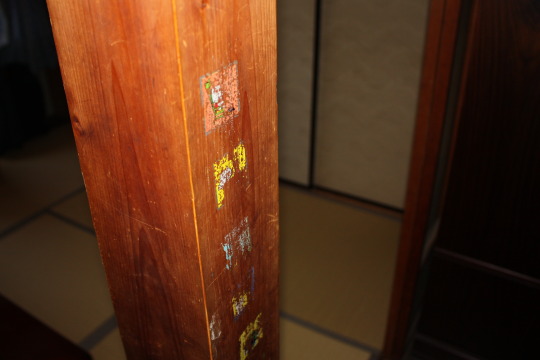
jump to the table of contents 目次のページへ
next page 次ページへ
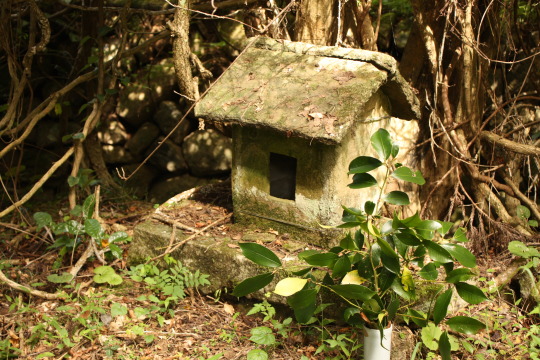
A small shrine of 田の神様TA NO KAMISAMA(paddy field god)
Strolling countryside in Japan we sometimes find a small shrine beside paddy fields. It’s for TA NO KAMISAMA. In our faith and folklore he comes down from mountain to village area every February. People enshrine him next to their paddy field. And he stay there until October to guard farmer’s agricultural work. And after harvest he returns to mountain. This is a basic pattern of Japanese agricultural faith.
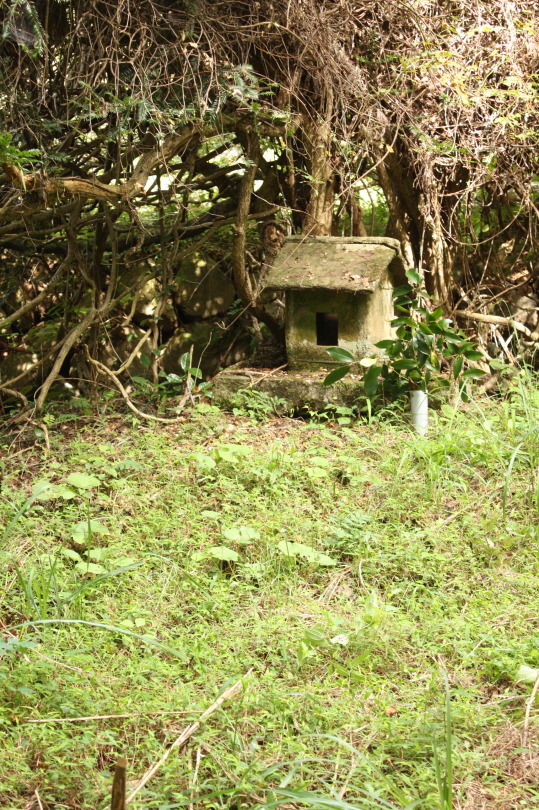
Now I found TANO KAMI SAMA when I was taking photos of flowers. But the paddy field seemed to have been abandoned for long time. At first I felt disappointed. But I saw it twice and three times, and found there was Sakaki sprig. That is a offering.Someone offered it to the shrine.
The paddy field had gone. But the faith is still alive.
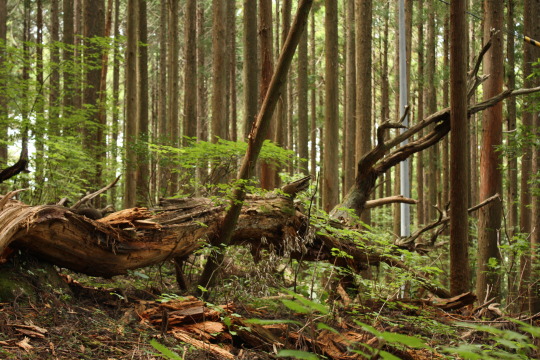

‘Enshu haguma’, endangered species
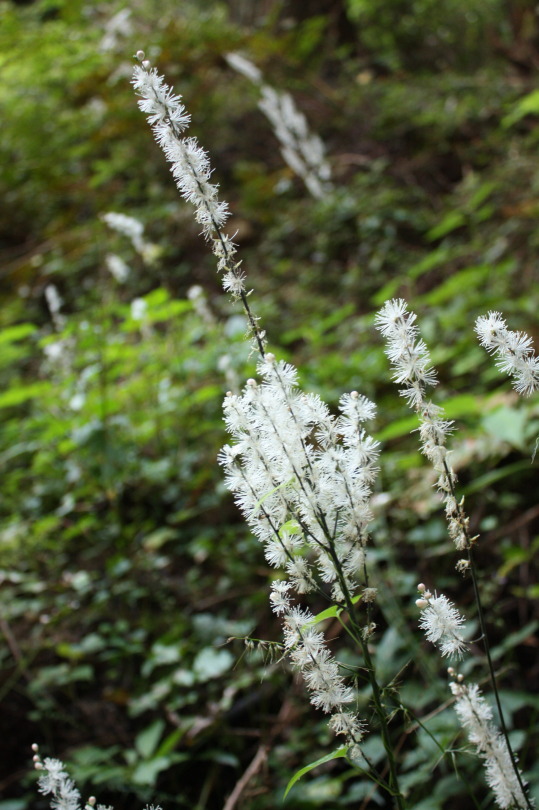
イヌショウマ
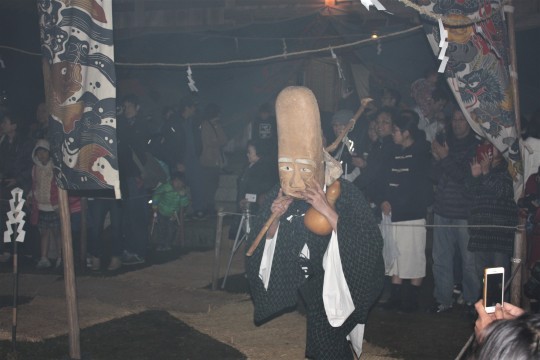
参候祭り Sanzoro Matsuri festival

poster
This Nov.9th our village Mitsuhashi is going to hold Sanzoro Matsuri festival. My wife and I live near the festival site (Tsushima jinjya shrine). When you visit there please look for the poster above. That is my house. There I’ll offer you Oden for free. Please eat Oden and enjoy the festival.
more info for Sanzoro Matsuri festival is here
今月の9日は私たちの集落三都橋で参候祭りがあります。観覧においでの方は、上記の手書きポスターを探してみてください。我が家の戸口に張り出しておきます。おでん、食べてってください。フェイスブックやタンブラーでいつも私の記事をお読みいただいている皆さんに、ささやかながらのご返報です。おでんを食べて、祭りを楽しんでいってください。
Autumn scene at Mitsuhashi, Japan
三都橋、秋の景色。参候祭りももうすぐです。by Shige
#したらぐらし #設楽暮らし #設楽町 #奥三河 #愛知県 #三都橋 #すすき #秋 #folklifejapan #mitsuhashi
https://www.instagram.com/p/B4bsUuQDkk8/?igshid=ix6soc610ig3
Post link

sunset, yesterday

sunrise in misty morning, today
設楽SHITARA and 新城SHINSHIRO, a land of flowers 02
SHITARA and SHINSHIRO are located between two big cities. One of them is 豊田TOYOTA. This is the city home of big automobile company TOYOTA. Another city is 浜松HAMAMATSU. Hamamatsu has automobile or motorcycle companies, too. SUZUKI, HONDA and YAMAHA. those companies were born in or near this city.
Though Shitara and Shinshiro are between two industrial cities,they show us very beautiful rural scenery. Steep mountains and deep gorges, and sometimes fertile plains and villages,having their traditional cultures.
Thank you for reading my post. I live in mountain area in Aichi pref in Japan. The village’s name is Mitsuhashi. I enjoy rural life there. If you are interested in Japanese life in mountain area, please take a look at my another article.
In the page and following pages I describe one woman’s history. At the time of ww2 and until today, how did she live her life ? I’ll show you it.
Post link
森林鉄道と、ある酒屋の物語 16(日本語&English)
A novel, of memorable liquor store and logging railroad 16
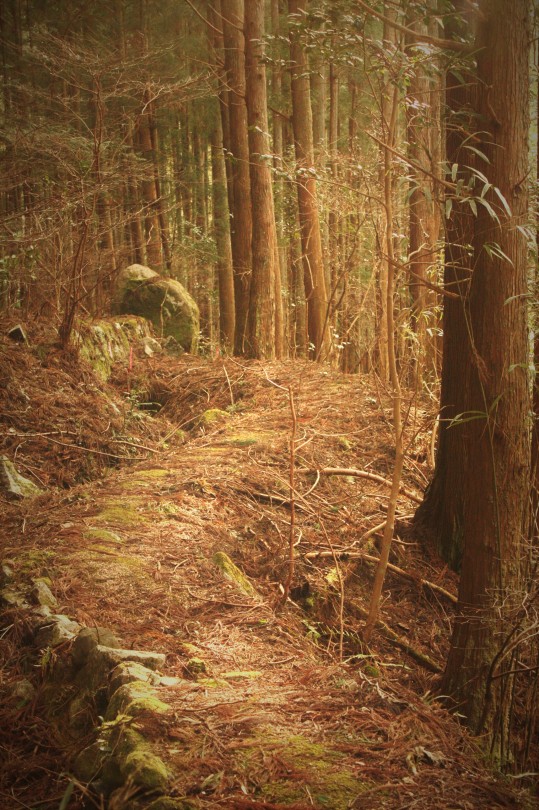
ex-railroad line 森林鉄道軌道跡
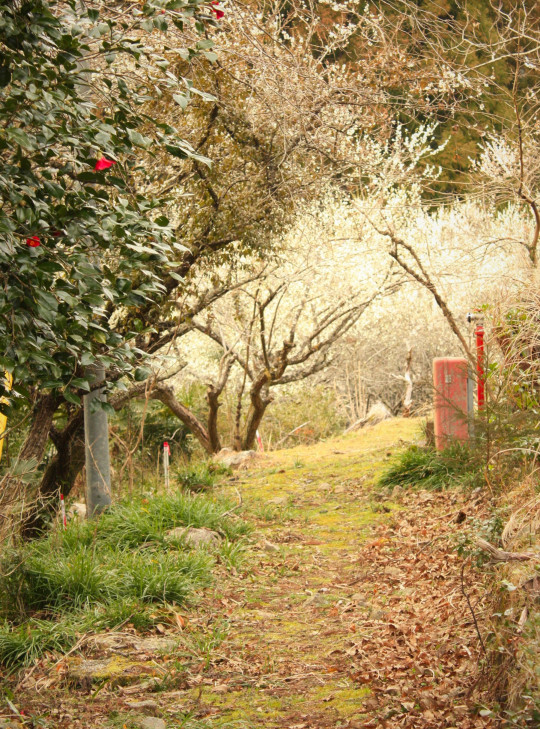
ex-railroad line 森林鉄道軌道跡
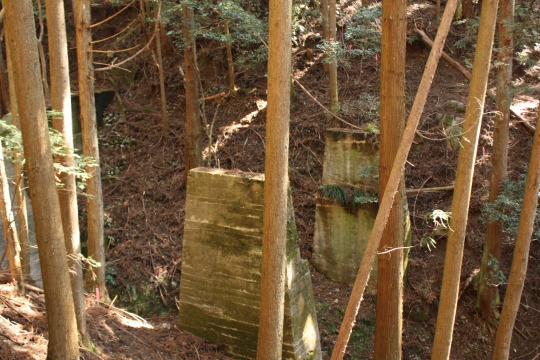
bridge pier 橋脚
田峯森林鉄道鰻澤線は昭和6年(1931)から33年(1958)まで、段戸の御料林(戦後は国有林)の木材を伐り出すのに活躍したトロッコ列車だ。ガソリンエンジン駆動の機関車が、下流の竹桑田からたくさんのトロッコを連結して、当貝津川沿いの線路を遡上してくる。トロッコ一つには一人の人間が担当としてついている。いずれも屈強な男たちだ。終着の鰻澤では、山から下りてきた丸太が待っている。列車はここで連結を解かれ、たくさんの単体トロッコとなる。フォークリフトなどの便利な機械など夢の中でも見たことのない当時、担当の者たちは己の腕力のみで丸太をトロッコに積み込んだ。積み込める丸太の大きさによって、給料の歩合が決まる。木こりたちも必死であった。単体となったトロッコに荷を積むと、あとは自由落下で竹桑田までもどって行く。つまり、動力なしのブレーキコントロールだけで、竹桑田まで「落ちて」いくのだ。このブレーキシューは木製で、1回の下り行程で3つか4つほどがすり減ってなくなる。これを作っておくのも担当者の役目で、シューを取り換え取り換えしつつ、トロッコを操るのである。
The logging railroad Unagisawa-line was at work from Showa 6 (1931) until Showa 33(1958) to convey logs from the national forest in Dando. A locomotive driven by gasoline engine pulled many wagons called ‘truck’ . It departed from the station in downstream area and went up along the river. Each truck had one rider who is in charge of it. All of them were tough men. At the terminal station Unagisawa, Logs cut down in the deep mountain waited for them to arrive. Here train was separated into wagons. As the riders did’t have such machines as fork lift each man lifted up those logs onto his wagon and load them only by his thick arms. Their wage was percentage pay. The more they transported wood the much money they were able to get. So they worked hard and hard. Then they got on his separated wagon heading to downstream. This time the wagon had no motive power. It was moved by free fall until downstream station. They controlled its moving by brake. To prepare the brake shoe was also their important job. It was made of wood. They made them and set them to the wagon. Three or four brake shoes would wear out per one descent travel.
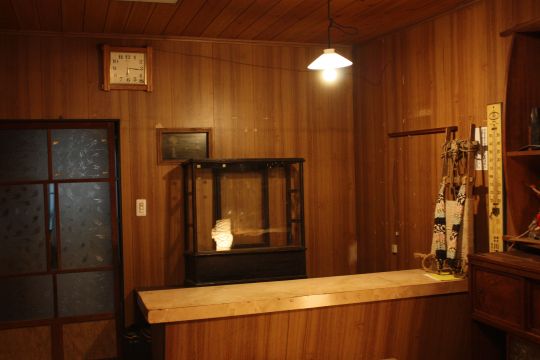
Chikakosan’s place
ちか子さんは、店番をしつつこれらの音を聞くのが好きだった。ガソリンエンジンの音、軌間762mmの軌道と輪のこすれあう音、ブレーキシューのすり減っていく悲鳴のような音。伊藤屋酒店のカウンターに座っていると、南からエンジンの音が近づいてくる。線路は、伊藤屋の近所の営林署官舎のあたりで東に大きくカーブを切っている。カーブを切り、しばらく栗島川に沿って遡上するのだ。伊藤屋から見れば森の奥に遠ざかっていく形になるので、音がだんだんと小さくなっていく。と、がたんがたんと橋で渡河する音が聞こえる。栗島川を渡った線路は、またこの川に沿って下ってくるので、伊藤屋に近づいてくることになる。そして、木の間がくれに列車の姿をみることもできる。森林鉄道の音は、ちか子さんにとって日々の楽しみの一つであった。
Chikako-san loved to hear the sounds of logging railroad in her liquor store. The sound of gasoline engine, the friction rub given off by rails and wheels, the sound like scream from brake shoes, and so on. Behind the counter she heard engine sound getting closer . It came from the south , that is, from downstream area. The rail turned to the east near her shop. So the sound became more distant and more faint. But soon it turned back to her place. In the depth of forest the rail went across the river by wooden bridge, and turned its direction to the west, toward her shop. And in the shade of trees on the cliff she was able to catch sight of train turning the direction again. This time it went to the north, heading deep mountain area. As it went, then the sounds got faint again.
The sounds of logging railroad was her great amusement in her daily life.
The area of Shitara town in Aichi Pref is pretty large. But civilized area is limited. Only five or ten minutes drive leads us out the artificial space. Now we arrive at the border where we can find fusion of nature and old human culture.
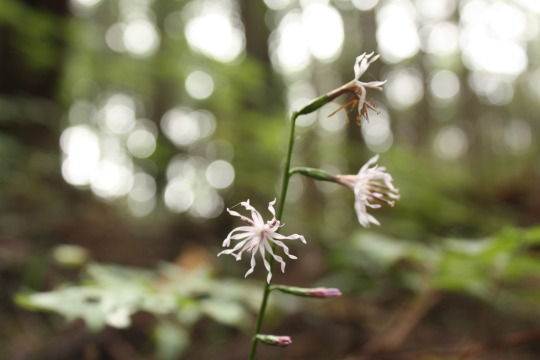
Above is ‘Enshu haguma’, endangered species
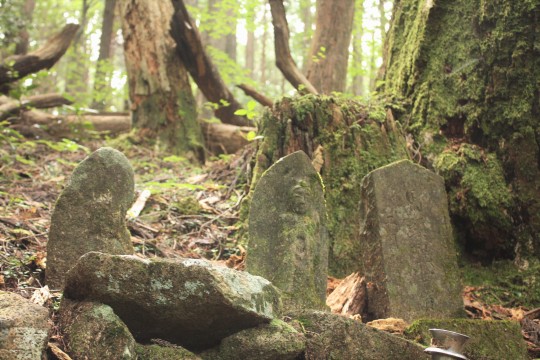
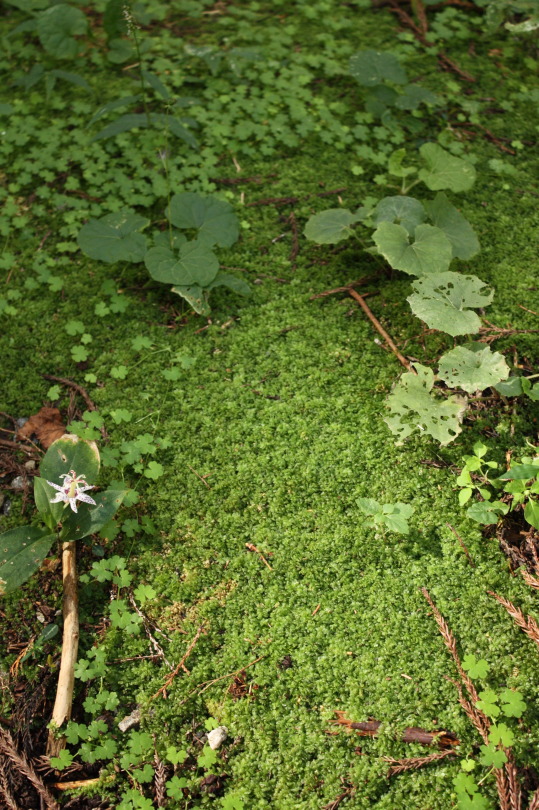
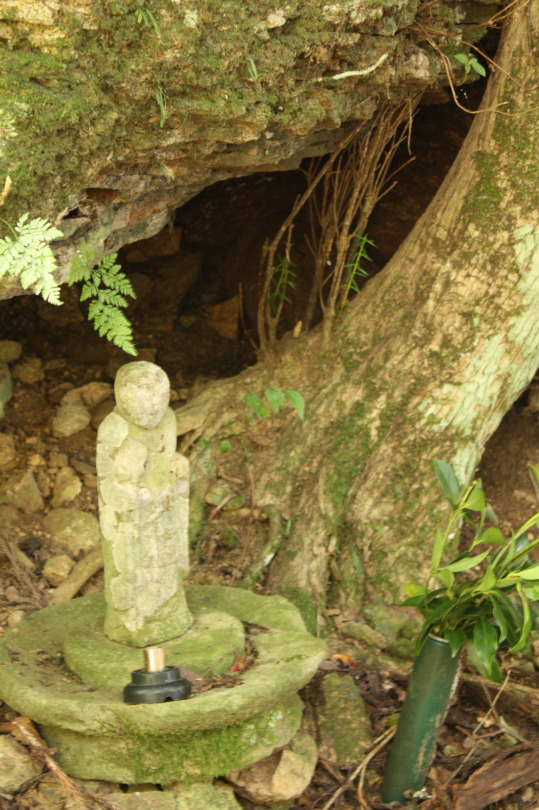
A novel, of memorable liquor store and logging railroad 14,15
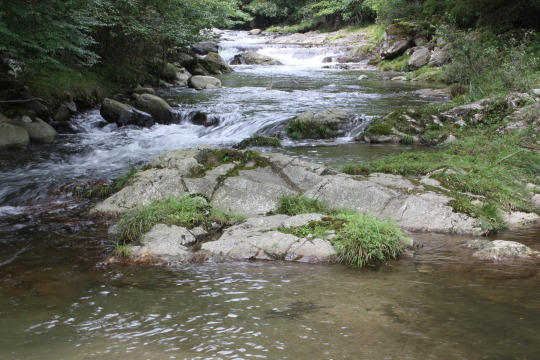
当貝津川。森林鉄道はこの川に沿って北上した
Tougaitsu River. Logging railroad went up north along this river

森林鉄道のトンネル A tunnel for the logging railroad
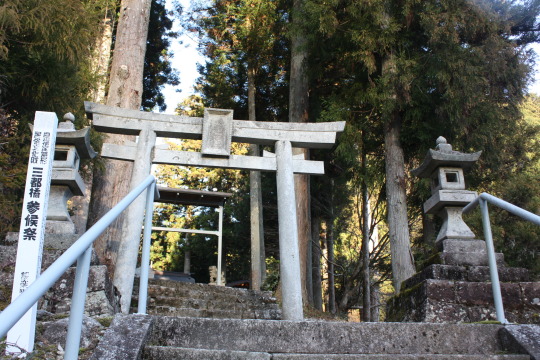
三都橋の津島神社 子供たちはこの石段のすぐ下の小道を通って通学した
Tsushima jinja shrine with stone step in Mitsuhashi. Every morning children went to school through the road which is at the foot of this stone step.
14
それから数日後のことである。
伊藤家の座敷で、大きな座卓をはさんでちか子さんと差し向いに座っているのは、正之さんであった。
当惑と緊張の空気が、部屋の中に満ちている。いや、緊張しているのは正之さんの側だけだったかもしれない。耳たぶまで真っ赤にし、額に汗を浮かべている正之さんを、年上のゆとりであろうか、ちか子さんはさりげなく眺めていた。手拭いを出して額の汗を拭く正之さん。と、きっと顔を上げ背筋を伸ばして、意を決したように、長い長い沈黙を破る。
「ちか子さん」
「はい」
「僕と、夫婦(めおと)になってください。」
ほんのわずかの沈黙。そして
「よろしいんですか」
「もちろんです。いったい何を…」
「五つも年上なんですよ」
「にいさんが、忠利さんがあなたをめとられたとき、正直、うらやましいなと思いました。あぁ、なんときれいなんだと。なんてきれいなお嫁さんなんだろうと。だから、結婚を、と」
正之さんは、自分の返答がまったく脈絡を失っていることに気づいていないようだった。ただ、その情熱はちか子さんの胸に十分届いた。
ややあって、
「はい。一緒にこの家を盛り立ててまいりましょう」
そして3年の月日が二人の仲を日々温めて過ぎていった。時は昭和23年を迎える。
It was few days later that we were able to find two persons sitting in Japanese reception room of Ito family’s house.
Masayuki-san and Chikako-san sat face to face at the big low table on tatami. The room was filled with a tense atmosphere. Especialy Masayuki-san, being under huge tense, he was abashed and sweated bitterly . As for Chikako-san, due to being elder than Masayuki-san, she was able to afford to observe his behaivor. Masayuki-san took Japanese towel and wiped sweat on his forehead. Then he determined and straightened himself. He broke long silence in the room.
’ Chikako-san ’
’ Yes ’ she replyed.
’ Will you,, Will you marry me ? ’
after moment of silence, Chikako-san asked
’ Do you think I’m appropriate to your wife ? ’
’ Yes, of course. What do you mean ? What do you worry about ? ’
’ I’m five years older than you ’
’ I loved your late husband Tadatoshi-san like my brother. But honestly speaking when you got married with him I envied him a bit. How beautiful bride you were ! How beautiful! How happy I would have been if I had got married with you, I imagined.’
Masayuki-san asserted earnestly .
He was too eager to keep calm. He got beside himself with his passion. And it hit Chikako-san’s heart.
’ All right. Let’s make this family prosper together’
And three years had passed with love and trust.
It became Showa23(1948).
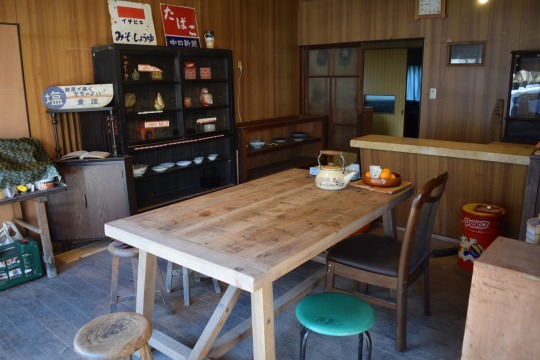
残された看板から、伊藤屋が様々なものを売っていたことが分かる。たばこ、みそ、塩、そして画面右端を見るとミルキーの巨大な缶!
Sign boards left in the shop space tell us that many kinds of stuff had been for sale here, such as miso, cigarette, salt and candy
15
昭和23年。沿岸部の都市は戦争の被害からいまだ復旧していなかった。その一方で、山間部の村々にはいち早く活気が戻っていたのだった。
小学生たちの登校の波が引くと、ほどなく、南の方から列車のやってくる音が聞こえてくる。ガソリンエンジン車に牽かれた森林鉄道のトロッコだ。田峯方面からやってくるこの木材運搬用列車は、田口線田峯駅に向かっていま歩いている正之さんと、どこかですれ違っているはずだ。
「国鉄の社員と酒屋の切り盛り。ちょっと見ない取り合わせだわ。でも、きっと、きっと大丈夫。ですよね、正之さん」
そうつぶやいたちか子さんは、店の中に戻り、赤子を負うたままカウンターの内側に陣取った。
旧伊藤屋(現かっぱ亭)には「新城税務署酒類販売免許店」という監察札が残されており、その裏面には「免許 昭和二十三年五月一日 伊藤ちか子」とある。伊藤屋あらため「伊藤屋酒店」である。このとき、ちか子さんは24歳。母となり、酒屋の若女将となった年であった。
Showa 23 (1948). Cities in coastal area had not recovered from the damages of war yet. On the other hands villages in mountain area were vibrant.
Passing by Tsushima jinja shrine Torii gate, a throng of children had gone toward their elementary school. And then Chikako-san heard a sound that logging railroad train gave off. The train, that was driven by gasoline engine, was consist of many small wagons called ‘truck’ . This train came from Damine station to convey wood from deep mountains. Chikako-san’s husband Masayuki-san was on his way to Damine station then. He had to go to Damine on foot and get on another private train there to go to his workplace. He was an employee of Japan National Railway. It was a hugest company in Japan at that time.
Chikako-san talked to herself ’ I manage a liquor store and my hus is emploee of big company. It’s a funny combining. But it’ll go well, it will go well. Don’t you think so ? , my hus Masayuki-san’
Then carrying her baby on her back Chikako-san entered the house and took up her position behind the counter.
The license board written ’ A shop having permission to sell liquor’ is left in ex-Ito-ya store (now Kappatei). And on the back side of it there is a description, that is,
’ license given in May 1st Showa 23, Ito Chikako’. Ito-ya store was opened as a grocery store by her parents-in-law. It was around the end of Meiji era. And then Chikako-san added selling SAKE to miscellaneous goods. It was Showa 23 (1948). This year she was 24 years old, gave birth to her baby, became mother and became a proprietress of liquor store.
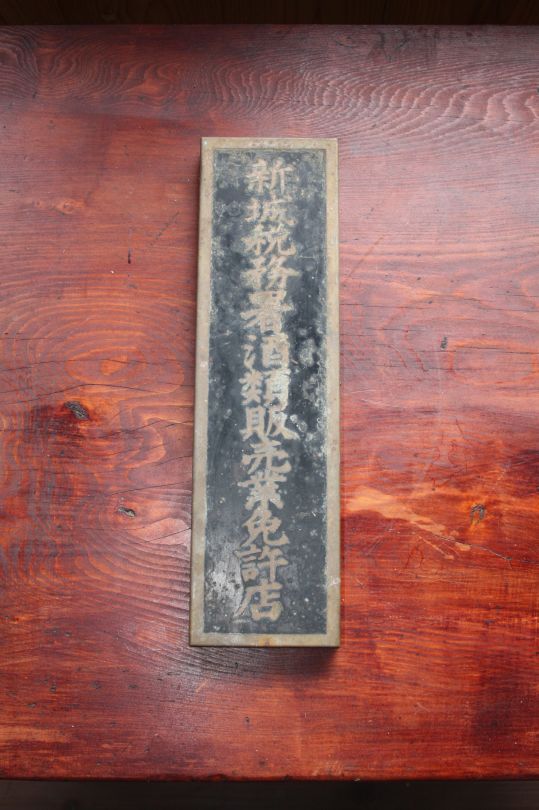

酒類販売の監察札(現物)
The actual thing of license board given to Chikako-san
三都橋の彼岸花
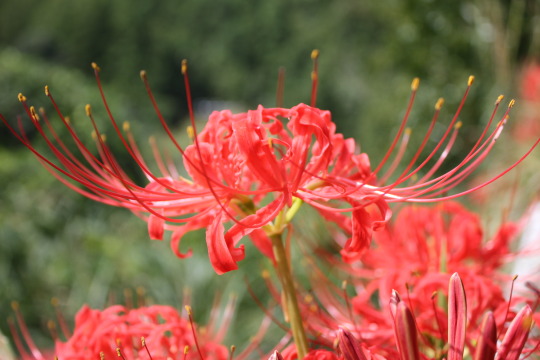
We Japanese have some particular days when we believe spirits of our ancestors come back to this world from the world after death. Most important and famous is BON in July or August. Beside it, around Vernal Equinox Day and Autumnal Equinox Day we have days called HIGAN彼岸. This word means ‘another side of the river’. Of course it is a land of the dead people.
During these days we visit family tomb to hold a memorial service for our ancestors.
Equinox Flower( we call it 彼岸花HIGANBANA) blooms during this term. It reminds us of the coming of HIGAN season.

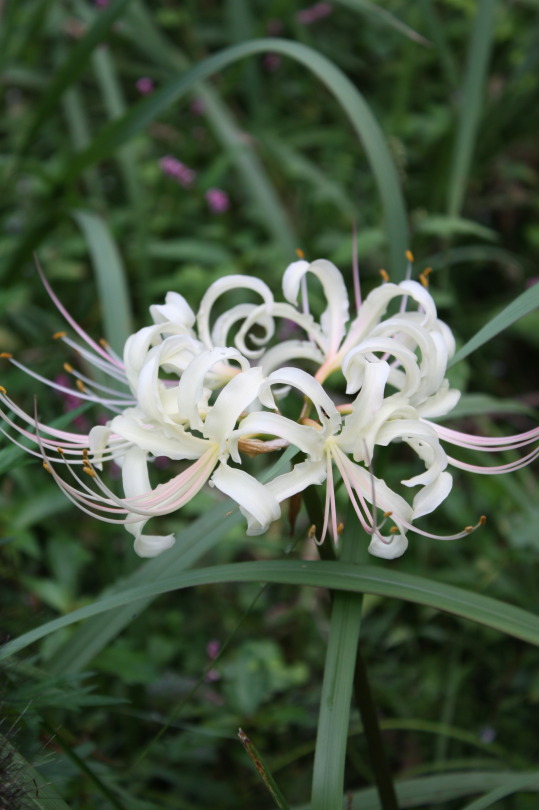
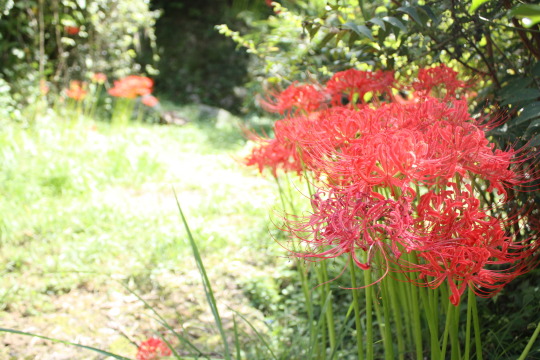
Thank you for reading my post. I live in mountain area in Aichi pref in Japan. The village’s name is Mitsuhashi. I enjoy rural life there. If you are interested in Japanese life in mountain area, please take a look at my another article.
In that page and following pages I describe one woman’s history. At the time of ww2 and until today, how did she live her life ? I’ll show you it.
A novel, of memorable liquor store and logging railroad 13
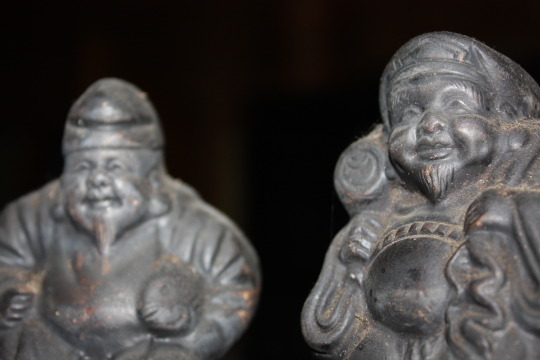


Photo: statues of Ebisu and Daikoku, gods of happiness. Chikako-san enshrined them in the kitchen for a long time. 恵比寿と大黒の像。長い間台所に祀られていたようです。
三都橋の伊藤家は、伊藤仲吉さんとなつさんという夫婦から始まる。忠利さんの両親である。明治の終わりごろに三都橋に移り住んで、商売屋を営んでいたものと思われるが、定かではない。店の「売上帳」「支払帳」等が残されているが、場所と年代がはっきり記されているものは、大正13年の売上帳で、これには「三都橋 伊藤屋」と表書きされている。扱っていたのはタバコや炭だったらしい。
終戦直後からの数年間は、どの日本人にとっても激動の歳月であった。家の唯一の跡継ぎである忠利さんを失った伊藤家では、問題は一層深刻であった。家名途絶の危機である。当時の日本人は、これを先祖に申し訳の立たぬ惨事ととらえ、回避するために手を尽くした。
Mr. Nakakichi Ito and Mrs.Natsu Ito established their home in Mitsuhashi, and they began the history of Ito family. They were Tadatoshi-san’s parents. They moved here and opened a grocerystore.It was suppose to be at the end of Meiji era (1868-1912), but uncertain. They left some account books of their business. The oldest book which we can find the year and place name on it cleary is a purchase book of Taisho 10 (1921). We can read the letters ‘大正十年一月 January Taisho 10 ’ and ’ 三都橋 伊藤屋 Mitsuhashi Ito-ya ’ on its front cover. Seeing that book, we can know they sold cigarette, charcole and so on.
For several years after the end of the war, all Japanese people experienced severe days. Especially Ito family did. Tadatoshi-san was a only one son, who had been expected to inherit the family line. But he had gone. In those days for Japanese people, Interruption of pedigree was huge sin against ancestors. In this case they used to try every possible means to avoid this tragedy.
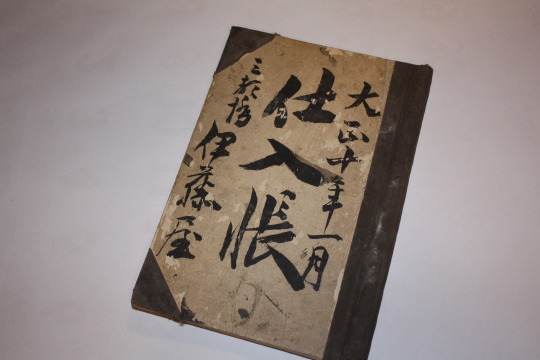


Photo :伊藤屋商店の帳簿 明治40-大正10
Ito-ya grocery store’s account books(1907-1921)
戦後まもなく、ちか子さんはお舅さんとお姑さん(仲吉さんとなつさん)に呼ばれた。
「折り入って話がある」と、仲吉さんが言う。
「伊藤家を守ってもらえないだろうか」
ちか子さんはどきりとした。
果たせるかな、亡くなった忠利さんの代わりに、伊藤家の親戚筋の若者と結婚し、その夫婦で三都橋伊藤家を継いでいってもらえないかという話であった。いわゆる両養子である。
「え、あ、 あ、 でも」
とっさのことに声も出ないちか子さん。この時代、これはよくある慣行ではあったが、自分の身の問題となると、平静ではいられない。
「あの あの 一体どなたを?」
「正之君だよ」
ああ、あの人か。忠利さんのことを「にいさん、にいさん」って慕ってくれている若い方だ。でも、それは…
「私の方がずっと年上じゃありませんか」
「あの子は昭和3年生まれだからね。四つ五つ、ちか子さんの方が年上か」
ちか子さんは口の中がからからに乾いていた。やっとの思いでこう言った。
「正之さんが、そんな年上女との縁談は、、、お嫌と思ってらっしゃるのではないですか」
「それは本人に聞いてみるのが、間違いないじゃろう」
Soon after the war Nakakichi-san and Natsu-san ,Chikako-san’s parents in law , consulted her.
Her heart beat fast with a hunch.
’ There is a special favor that we need to ask you. Would you pitch in and help to keep our family ? ’
As she anticipated it was a matter of her next marriage. In those days to maintain the family pedigree was the huge problem which people had to override than anything. Tadatoshi-san, Chikako-san’s first husband, had passed away. So Nakakichi-san and Natsu-san asked her to get married with a young man who belonged to Ito family’s close relatives and begged her to keep the family blood with the person.
It was an ordinary way to solve the issue of successor. But when it became on herself she could not help feeling agitated.
'But, but,,, who ? With whom ? ’
She was thrown into confusion.
'We think of 正之Masayuki-kun as your husband ’
Chikako-san thought and talked to herself
'I know, I know him’, 'A young man who was attached to Tadatoshi-san like a true brother’
'But he is,,, I’m,,’
She said aloud 'I’m much older than him’
'Yes, he was born in Showa 3. So you are four or five years’ older than him.’
She felt uneasy more and more. She felt serious thirsty, and asked
'Is he OK ? I’m afraid I’m too old to get married with him’
’ You’d better make it sure by yourself in person.’
A novel, of memorable liquor store and logging railroad 12

Photo: 津島神社 Tsushima jinjya shrine
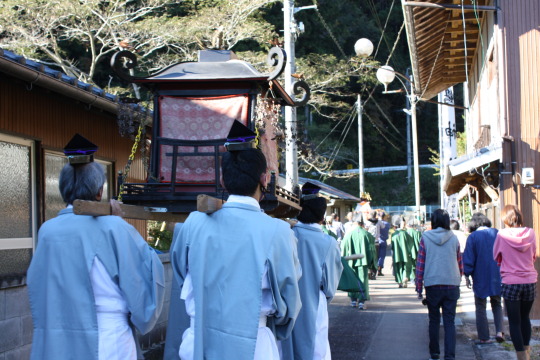
Photo: 参道を行く参候祭りの行列。かつてこの道は商店街でした。街路灯の明かりの形が、商店街だった往時をしのばせます。画面左に見える家が旧伊藤屋酒店(現 かっぱ亭)/ A procession of The Sanzoro Matsuri festival.Once this road was a shopping district. The shape of the street lamps reminds us those days. A house you can see the left side in this photo is ex-Itoya liquor store (now Kappatei).
背に負うた赤子がむずかったので、ちか子さんは追想の夢から我に返った。店先を渡る風が、秋の深まりを告げている。昭和23年10月。生後半年のこの子は、正之さんとちか子さんの長男である。ちか子さんは赤子をあやしながら、店の前の道の掃き掃除に取り掛かる。「伊藤屋酒店」という真新しい看板の下の三和土は、特に念入りに掃き清める。手に思わず力が入るのだ。
ぼつぼつと、小学生たちの登校時刻になってくる。一人二人、四人五人、そしてわらわらと、怒涛の如く、大勢の小学生が店の前を通っていく。毎朝の光景である。ここは小さいながらも、津島神社門前の商店街だ。南からこの道を通り抜け、神社を横手に見ながら栗島川を渡っていけば、ほどなく三都橋小学校である。また、小高い所にある営林署の官舎からの小道も、伊藤屋の前で商店街に合流している。官舎の家の子供らも、ここで通学の列に加わるのだ。ほんの10分か15分ほど、伊藤屋の前の道は小学生でごった返す。毎朝の光景である。
「いとやさん、酒屋始めるのけ?」「おらにも一杯、飲ましてくりょ」
生意気なことを言いながら、通り過ぎていく。が、その言葉に間違いはなく、大人になったのち、この子らの大半は「いとや」の常連になるのであった。

Photo: 旧三都橋小学校(現 交流センター)ex-Mitsuhashi elementary school
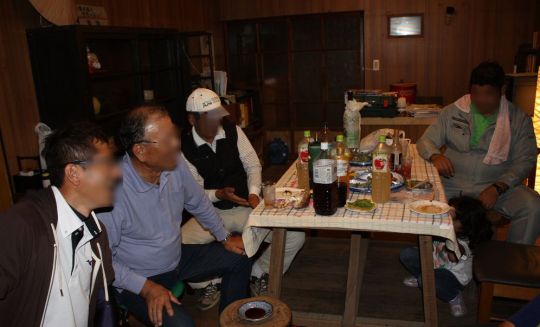
Photo:現在のかっぱ亭(旧伊藤屋酒店)。今も昔も、お酒を飲むところです。
Today’s Kappatei ( ex-Itoya liquor store). The place to drink with fun, in those days and also today
Fretful cry of her baby, whom Chikako-san carried on her back, awaken her from daydream of reminiscence. A Wind that blew around the storefront told a deepening of autumn. It was October of Showa 23 (1948). This baby, at the age of six months, was an eldest son between Chikako-san and Masayuki-san, her second husband. Dandling the baby on her back, Chikako-san began to sweep and clean the road in front of her liquor store. She cleaned around her store earnestly, especially the concrete floor under the sign ‘Ito-ya liquor store’ . The new hope toward the future made her vivid.
It was getting to be the time for children to go to school. One two, four five,and many. Like a flood, many children pass the road before Ito-ya liquor store. Though this street was short and narrow but it was a shopping district in front of Tsushima jinjya shrine. And another path from Forest Service’s official residence, where some families lived, joined this road here. For a while in the morning, maybe 10 or 15 minutes, the street was crowded with children going to Mitsuhashi elementary school. They each said something impertinent, like this
'Itoya-san, you open liquor store ?’
'Can I have a cup of SAKE ?’
But as they said, later, when they grew up, they became good custmers of Itoya liquor store.
A novel, of memorable liquor store and logging railroad 11
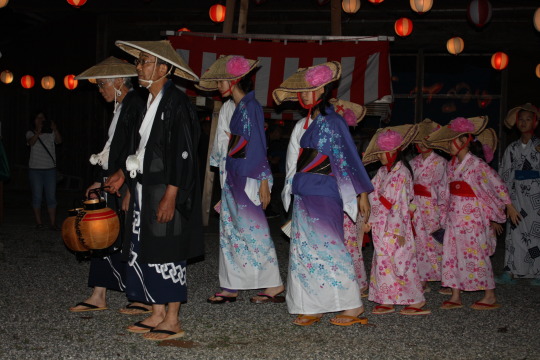

Photo 田峯の盆 damine no Bon
戦局はますます悪くなってくる。「豊橋の海軍工廠がB29の編隊に襲われた。学徒も工員もたくさん死んだらしい」「浜松は艦砲射撃でやられたらしい」等、たくさんの「らしい」が飛び交ったが、それらは間違いなく真実だった。多くの人の死が、積み上げられていった。
そして、昭和19年9月。忠利さん戦病死の報が届いた。「別府海軍病院入院加療したがその効なく昭和19年9月9日病死した」と後世の文献資料は書き記している。
設楽町内の田峯観音高勝寺には、戦後に建立された戦没者慰霊碑がある。この表に、数多くの戦没者に混じって、「伊藤忠利」の名前が刻まれているのを見ることができる。毎年8月には「田峯の盆」と呼ばれる、死者を悼み祖霊を懐かしむ行事があるのだが、必ずこの石碑の前で念仏が唱えられる。魂魄となった忠利さんも、この場に帰ってくるのだろう。
戦争による肉親との死別は、いまだ消えない傷となって、設楽の人々の心に残っている。
訃報に接したその時、ちか子さんは声も出せず、ぼたぼたと大粒の涙をこぼした。
「広島に新型爆弾投下さる」「長崎にも新型爆弾」「ポツダム宣言受諾」。こうして日本は、昭和20年(1945)8月15日を迎えた。
つづく
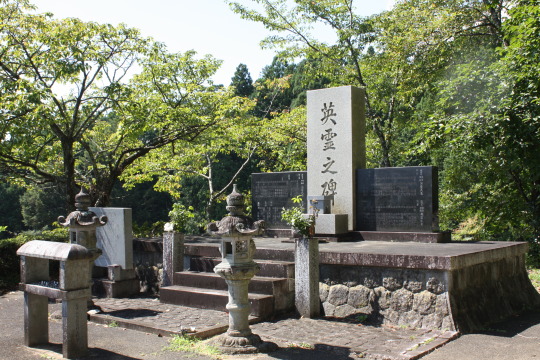

Photo 田峯観音高勝寺にある戦没者慰霊碑
War memorial monument at Damine Kannon Koshoji temple
War situation got worse and worse. People said each other ‘I heard Navy arsenal in Toyohashi was bombed’ 'I heard Hamamatsu was attacked by gunfire from warship’ . People said many 'heard’. Those weren’t rumors but the truth. The bodies lay in heaps here and there.
And September 9th Showa19(1944), Ito family received a letter telling Tadatoshi-san’s death from a disease contracted at the battle front. The documentary record edited later says 'He entered Beppu navy hospital to be treated but in spite of all medical aid he died from disease in September 9th Showa19’.
There is a war memorial monument in Damine Kannon Koshoji Temple in Shitara town. On it we can see many soldiars’ names carved, who were killed by war. Among them we can find Tadatoshi-san’s name , too. Every August they hold a festival called 'Damine no Bon’ to mourn the death of their family member and to think fondly of their ancestor. August 17th, they have a ceremony to chant sutra in front of this monument. This is a very important part of a series of ceremonies because the pain of lost are still alive in people’s mind.
We Japanese believe that dead people’s spirits come back to this world on this specific Bon days. Tadatoshi-san’s spirit also does, I think.
The feeling of grief was so huge that Chikako-san even could not cry loudly. She was able to do nothing but drop many large tears at the news of her husband’s death.
Hiroshima, Nagasaki. Fatal damages were reported in a row. And at last Empire of Japan had gone . It was Showa 20(1945).
to be continued
jump to the table of contents 目次のページへ
A novel, of memorable liquor store and logging railroad 10
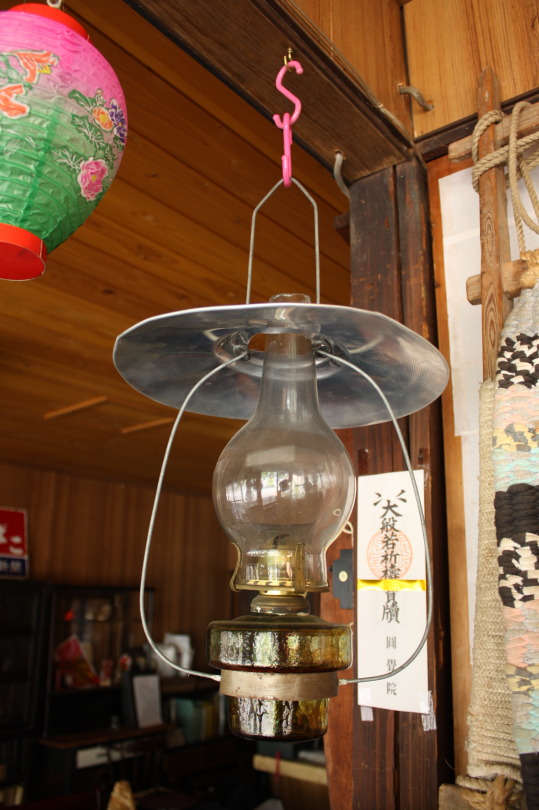

祝言の日はあわただしく過ぎた。その夜、ほの暗いランプの明かりの下でのことである。
家の中をひとしきり案内した後で、忠利さんは竹製のペン立てを手にとって、ちか子さんに言った。
「これは中学生のころ、僕が作ったんだ。見てごらん」
手渡されて、そのペン立てのおもてを改めるちか子さん。乏しいランプの灯でも、黒々と墨書された文字が見て取れる。「武勇」「忠節」、そして「かかるときさこそ命はおしからめ、かねてなき身と思ひ知らずば」という和歌が、そこにはあった。
「忠節という言葉は、好きなんだよ。自分の名前の一文字だからね」
「この和歌はあなたが?」
「いや、太田道灌の作った歌だ。侍である自分はいつでもいくさの場で死ぬ覚悟があるという意味の歌だ。これは僕の覚悟でもあるんだ」
「そんな、、、どうかご武運を、、、生きて帰ってください」
「伊藤家を守ってくれ。自分は、、自分は、、どんなになっても帰ってくるから」
そして翌朝、忠利さんは軍務へと戻っていった。
つづく
The wedding ceremony day had passed in a fearful hurry. At the late night of that day this new born couple could have enough time to have conversation eventually. Under the poor lamp light, Tadatoshi忠利-san handled a pen stand made of bamboo and shown it to his wife Chikako-san. ‘I made it when I was a boy’. Chikako-san took it in her hands and checked it. On its surface she could see some kanji and hiragana written in India ink. '武勇BUYU (valor)’, '忠節CHUU-SETSU(loyalty)’, And Tanka poem, that is, 'かかるときさこそ命はおしからめ、かねてなき身と思ひ知らずば KAKARUTOKI SAKOSO INOCHIWA OSHIKARAME, KANETENAKIMITO OMOISHIRAZUBA ’.
Tadatoshi-san said, ’ 忠TYU, I love this kanji because my name contains this Chinese character’.
Chikako-san asked 'And this Tanka poem, did you compose it ?’
'No it was by Oota Dokan, a famous samurai leader. He says in this poem that he is willing to die in battle field in any time because he is a samurai.’ 'And I myself ’ said Tadatoshi-san, ’ I have the same readiness and determination like him’
'No, no,no,no, please come back to me safely,,,,, . May the fortune of war be with you’
'Keep our family, please make our Ito family survive. I, I'will come back here if I’m alive or even if I would become a spirit’
Then, next morning, he returned to his corps.
to be continued
jump to the table of contents 目次のページへ
A novel, of memorable liquor store and logging railroad 09
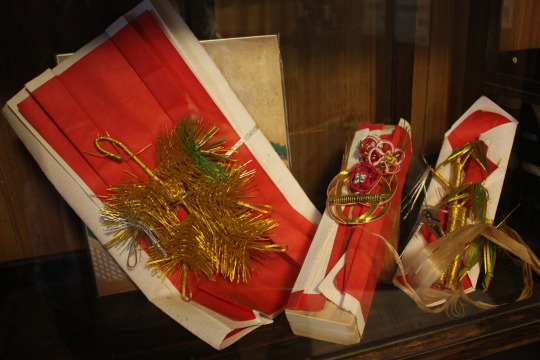
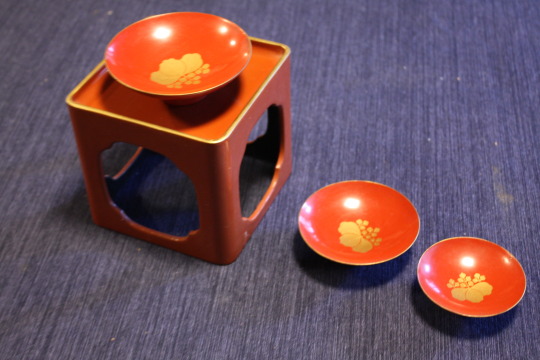
↑ Japanese wedding items
ちか子さんは、同じ設楽町内の清崎から、ここ三都橋の伊藤家にお嫁に来た。太平洋戦争も後半に差し掛かり、戦局が危うさを増してきたころのことであった。結婚の相手は伊藤忠利さん。ちか子さんの一人目の夫である。
忠利さんは伊藤家の長男で、地元の農蚕学校を卒業後、当時世界屈指の士官学校といわれた江田島兵学校に進んでいた。そして、昭和11年には呉海兵団へ入団、ウースン敵前上陸作戦などの危険な任務にも従事した、いわば、海軍のエリート候補生なのだった。
Ms. Chikako was from Kiyosaki in Shitara town and got married with one of member of Ito family living in Mitsuhashi. It was the latter half term of the world war 2. At that time the war situation gradually had got worse and worse for Japan. Chikako-san’s marriage partner was Mr.Tadatoshi Ito, he was her first husband and the only child of Ito family. He graduated local agricultural school and entered Etajima naval academy that was one of the most excellent naval academy in the world then. The 11th year of Showa era (1936), he was attached to Kure marine corps and engaged in some dangerous missions such as landing in the face of the enemy. He was a cadet of Japan Navy.
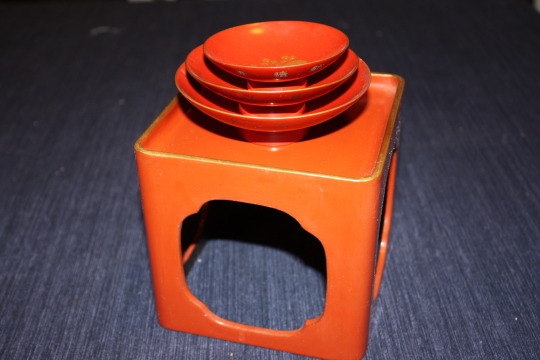
設楽町の女学生の間では、「三都橋にかっこいい軍人さんがいる」という噂で、早くからもちきりであった。海軍士官の白い制服は、どこにいても嫌でも目に付く。まして、山間部に向かう田口線の中では、いやでも注目の的になる。忠利さんが軍務の合間に帰省すれば、その噂はあっという間に設楽町内に広まった。
He was a famous and fabulous man among the school girls in Shitara town. ‘In Mitsuhashi there is a cool soldier’. They used to say. Actually, an white uniform of Japan Navy was very showy. People who happened to see Tadatoshi-san in Taguchi local line talked of his returning. 'He came back to Mitsuhashi on furlough’ . And the information was spreaded throughout Shitara town immediately.
その忠利さんと伊藤家が、家の嫁に、我が妻にと、白羽の矢を立てたのが、ちか子さんだった。ちか子さん、二十歳前の白無垢姿であった。
It was Chikako-san whom Tadatoshi-san and Ito family focused on as a bride. Chikako-san accepted their offer and worn Shiromuku , that is a Japanese traditional bride outfit. At that time she was 20 years old or younger.
つづく to be continued
jump to the table of contents 目次のページへ
A novel, of memorable liquor store and logging railroad 08
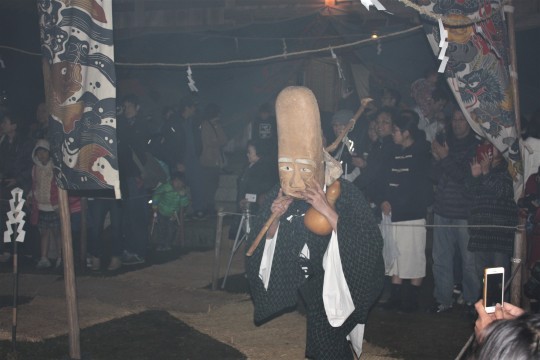
参候祭り sanzoro matsuri festival , belief in mountains in Japan
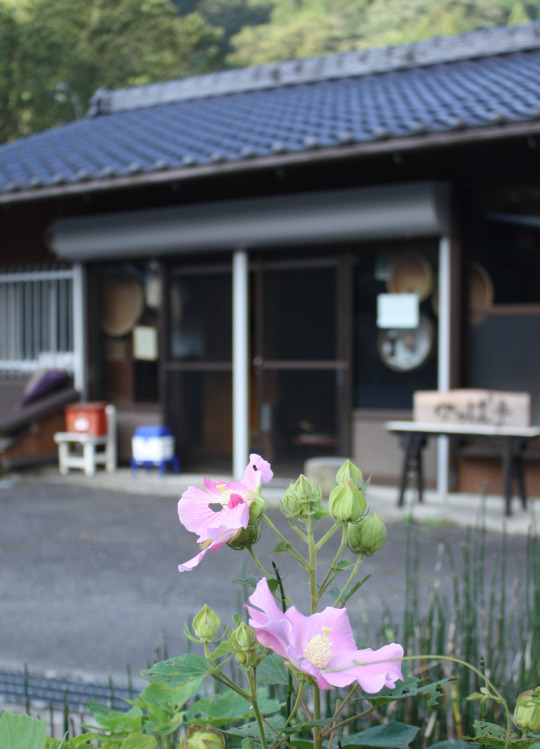
かっぱ亭(旧伊藤屋酒店)Kappatei (ex-Itoya liquor store), life in mountains
昭和23年(1948)10月のある朝。
太陽はまだ田峯の山の陰にある。空気はピンと澄んで、日ごとに秋の気配が深まっている。そういえばもうじき参候祭りだ。祭りの日を心待ちにする里の空気も、日ごとに募っている。それが、ちか子さんにはよく分かっていた。
重い玄関の引き戸を開けて、ちか子さんは言った。
「あなた。行ってらっしゃいませ」
「ああ」
正之さんはぶっきらぼうに答える。妻に優しげな言葉をかけようものなら、男の値打ちが下がる、そんな風な、張らずもがなの意地を張っている昭和の男の一人なのだった。
商店街の中を歩き去っていく夫の後ろ姿。5km余りの道を歩き、田峯の駅に出て、そこで初めて私鉄田口線に乗り、国鉄本長篠駅を経て、新城駅まで向かうのだ。通勤に2時間余もかかってしまう。
「仕事場がもう少し近くだったらいいのに」
そう、ちか子さんは思った。如何ともしがたい。正之さんは国鉄の職員だった。
ちか子さんは、歩み去っていく夫の背中に、海軍の白い制服を着たもう一人の人物の姿を重ね合わせた。
「あの人は、もっと遠くに行き、もっともっと遠くに行ってしまった」
つづく


「日本国有鐵道監修 職員用最新鐵道路線圖」昭和27年 伊藤正之氏遺品
折本の形で全国の鉄道路線図が収められている
Mr. Masayuki Ito’s belongings . All Japan railroad map for Japanese National Railways employee
One morning in October, 23rd year of Showa era(1948). The sun has not yet risen, it is behind Danine mountain. The air is cold and fresh. Day by day the climate tells us comming of autumn. Ms.Chikako knows the village people in Mitsuhashi are looking forward to the the day of Sanzoro festival. It’s a great festival of their village.
Ms. Chikako slided heavy door of their house and said to her husband . ‘Have a nice day’. 'Yes’ Mr.Masayuki responded laconically. Every man in Showa era thought it was a huge shame to utter to women frankly and gently. And he was one of them, too.
She see off him walking along shopping district. The private railroad station was more than 5km far from here. He had to walk that distance every day. Then he took a train for a while and next changed the train to Japanese National railways,,,, Ms. Chikako said to herself 'It is too far, he needs the place to work nearer ’.But they has no choice. Because Mr.Masayuki was a employee of Japanese National Railways.
Ms. Chikako superimposed another man’s figure having on white uniform on Mr.Masayuki’s back.
'He had gone farther, farther place. And never return’
to be continued
jump to the table of contents 目次のページへ
訪ねよう! 山の昭和と里のいにしえ

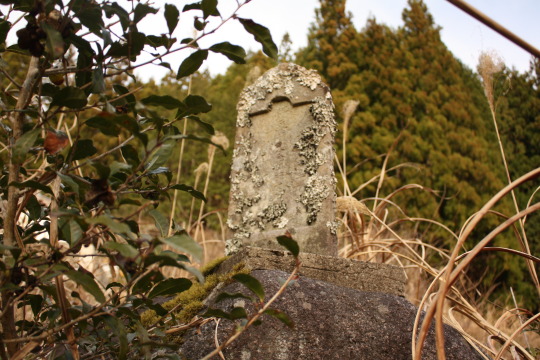
渡河地点をあとにして、森の奥へと入っていきます。すると、森林鉄道よりはるかに古い時代の文化の跡を目にすることができます。今にも壊れそうなお堂には、かつて観音様が祭られていました。11月の参候祭りでは観音様を乗せた神輿と稚児の行列が急な坂道を降りていき、津島神社に渡御するという式次第があったのです。今では観音様は別の建物に移されており、参候祭りの稚児行列はそちらが起点となっています。
線路跡が開けた田んぼの間を走るところでは、傍らに田の神様の石碑が建っています。日本の古い信仰では、毎年2月、山の神様が里に下りてきて田の神となり、稲作を守護してくれると信じられていました。そして、役目を終えた田の神様は、毎年10月には山に帰っていったのです。この石碑は、三都橋の人々の農作業を温かく見守っていたのでしょう。
田峯森林鉄道のレールや枕木は、今日ほぼすべて撤去されています。私の知っている限りでは折れ曲がったレールが顔を出しているところが一か所あるばかりです。一方、コンクリートで作られた遺物の方は、ところどころで見ることができます。山の産業遺跡ですね。

I leave the crossing site at the Mitsuhashi elementary school natural swimming pool and enter to forest. Then I can find many relics made by old culture in Japan. A temple building which is about to collapse was a hall for ‘Kannonsama’. Once village people enshrined 'Kannonsama’ in it. But people moved it to another temple building nearer their village, so today this building was avondoned.This Kannonsama plays a great part in Sanzoro-matsuri festival. I’m going to have another opportunty to talk you about it.
I can see a stone monument at the open space where the ex-railroad runs. It is a 'Tano kamisama (god of paddy field)’. In Japanese old faith people believed that Tanokamisama is also Yamanokamisama(god of mountain). In February Yamanokamisama comes down to paddy field in our village and changes its role to Tanokamisama, and it guards our agricultural work, then in October it returns to mountain. This is our folk and faith, very old faith.
As for this logging railroad most of rails and sleepers were removed. I know only one place where I can see the curved and bent rails. But in the forest I can find bridge pier or bridge beams. I think they are worth being said 'Industrial ruins’

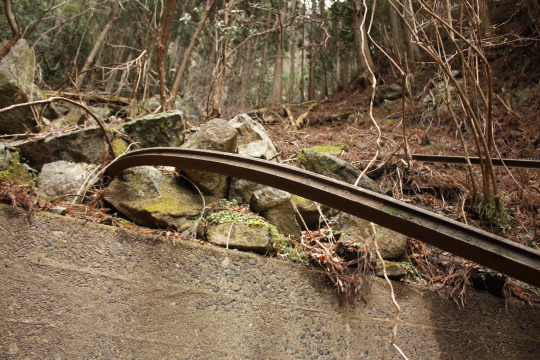
to be continued
→jump to the table of contents 目次のページへ
訪ねよう! 山の昭和と里のいにしえ
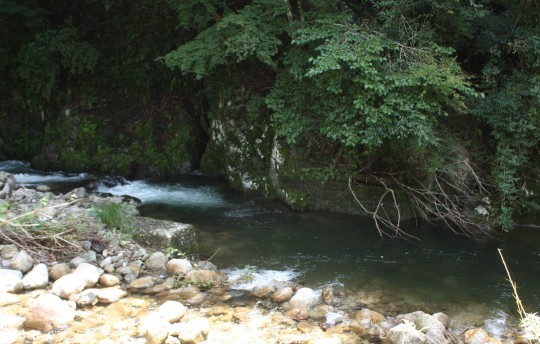
橋脚跡のコンクリーブロックと学校指定遊泳場所 natural swimming pool in the river

旧三都橋小学校 ex-Mitsuhashi elementary school
「いとや」(現かっぱ亭)の前の道は、子供たちの通学路でした。たくさんの子供たちが、毎朝ちか子さんの前を通り過ぎていったのでしょう。田峰森林鉄道鰻澤線は昭和33年には自動車輸送に道を譲り、廃線となります。しかし、「いとや」の商売はその後も長く続き、平成の時代まで商いを行っていました。
「いとや」から栗島川沿いの坂道を400mほど登ったところ、川のほとりの崖の上に、三都橋小学校は建っています。対岸を遡上してきた森林鉄道の軌道はこの地点で橋を渡り、こちら岸に来ます。そして、登校する子供たちの目の前で道路を横切ります。子供たちにとって森林鉄道の姿と、その走る音は、欠かせない日常の風景だったのでしょう。そして、もうひとつ。この橋の橋脚の足元の川の中は、学校指定の遊泳場所でありました。プールの無い学校だったので、栗島川の中の場所を指定して、学校公認の遊泳場所にしていたようです。学校の正門前に敷かれた軌道といい、川泳ぎといい、安全とか管理とかが口やかましく言われない時代なのでした。いかにも昭和、だったのです。たくさんの子供たちがかっぱのように川中で水浴びをしている、その頭上の橋を、トロッコがカタコトと音を立てて通り過ぎていく、そんな光景があったのでしょう。そして、子供たちは子供たちで、橋のうえに上って、橋げたの上を歩いて渡って、度胸試しをしたのでした。
橋を渡った森林鉄道は、再び森の中に潜り込み、木々の間を縫って上流を目指します。
A road in front of ‘Itoya-san’ was a school route. Every morning many children passed bofore Ms. Chikako’s eyes. The railroad was abandonded in Showa 33 (1957). But she ran her store for a long time until Heisei era.
Going up the slope way beside the river for 400m, children got to the elementary school building stands on the cliff by the river. The logging railroad ran up along the opposite side of the river and crossed the river on the bridge and appeared at the foot of the cliff which the school stands. Every morining and evening, the students saw the trucks move and hear the sounds given off from trucks. It was ordinaly scene for them. And one more thing. Mitsuhashi elementary school had no swimming pool. So teachers used the natural river instead of using artificial pool. The place in the river to swim was at the foot of the railroad bridge. The children swam like Kappa and the trucks loaded to capacity with logs went across above their heads. As for the children, they climbed the bridge and walked on it from this side to another. Of couerse it was to put their courage to the test.
There was no nervous minded person. That was Showa era.
After crossing the river, the logging railroad went into the forest again and headed to the upper stream.



A map for this chapter
→jump to the table of contents 目次のページへ
訪ねよう! 山の昭和と里のいにしえ
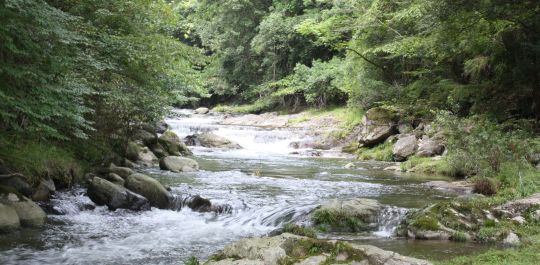
我が家のすぐ近くを流れる当貝津川 The river runs through Mitsuhashi
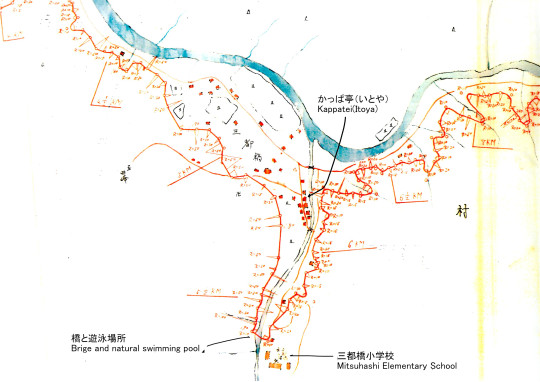
A map of logging railroad in Mitsuhashi, related this topic (written in 1947, retouched by Shige in 2019) 昭和22年に作成された三都橋地内の森林鉄道図。2019年にShigeが加筆
三都橋は二つの川の合流点に開けた集落です。 昭和22年に作成された「田峰森林鉄道台帳」に収録されている地図には、三都橋地内を流れ、合流する二つの川と、川に沿って走る森林鉄道が描かれています。
こういった資料や、地元の諸先輩や古老の皆さんにうかがった話などから見えてくるのは、活気にあふれた昭和前半の三都橋の姿です。国鉄飯田線本長篠駅から北設楽郡の郡衙である田口までは、田口線という私鉄が走っていました。この鉄道に接続する形で、「田峰森林鉄道鰻澤線」が敷設されたのが昭和6年。行き(上り)はガソリン駆動、帰り(下り)は自由落下走行、軌間762mmのトロッコでした。段戸山の御料林(のちに国有林)から伐り出された材木は、このトロッコによって運ばれ、竹桑田という所で田口線に積み替えられたのです。林業の隆盛に支えられ、森林鉄道の中核拠点である三都橋の里も大いににぎわっていました。自転車屋・鍛冶屋・パン屋・雑貨屋・酒屋など様々な店が軒を連ねていたのです。地図を見ると、たくさんの家が立ち並んでいるのが分かります。私の家「かっぱ亭」は、かつては伊藤さんというお宅が営む酒屋でした。酒屋であり、一杯飲み屋でもありました。いまでも、里の皆さんはこの家のことを「いとやさん」と屋号で呼びます。誰もが懐かしそうに、友情と敬意の響きを持って「いとやさん」と呼びます。その女あるじが、伊藤ちか子さんでした。
Long ago people came to the confluence of two rivers and established their village. That is Mitsuhashi. I have an old map of Mitsuhashi (written in 1947). You can see two rivers meet in the middle of the village and also you will notice the logging railroad running along the river.
I’ve read some books and interviewed with some senior people and got a vision of this village. The first half of Showa era (1926-1958), Mitsuhashi was a prosperous town. From Hon-nagashino St. to Takekuwada, there was a private railroad. And from Takekuwada, there were some logging railroads to ship logs. Small trucks driven by gasoline engine ran on the rail. When returning back, it was driven only by free fall. Mitsuhashi was one of important base of this railroad. Many workers and his families gathered to this village. So this village had many stores. Baker, bicycle shop, smith, grocery store and liquor store.
Yes, in those days, my house Kappatei was the liquor store which Ito family ran. The village people called, and even now call this house ‘Itoya-san’. It is a shop name. People use this name with respect and love. The proprietress of Itoya-san liquor store was Ms.Chikako Ito. She was popular with everyone.
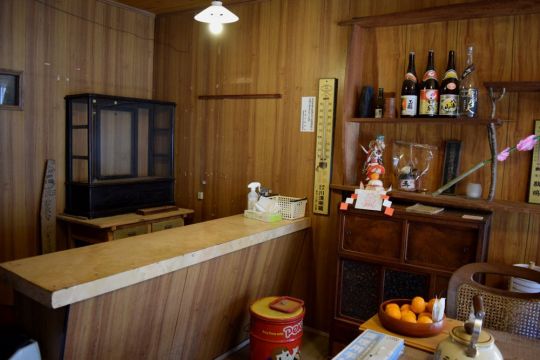
My house has a bar counter 民家なのにバーカウンターがあります。飲み屋さんだったころの名残。 棚の日本酒は今でも現役。時々、ご近所の皆さんと持ち寄り宴会を開きます

訪ねよう! 山の昭和と里のいにしえ
私の住んでいる三都橋は愛知県東部の深い深い山の中にあります。川の瀬音と降るような星空、朝は鳥の声に起こされ、夕方はヒグラシの合唱で一日を終えるという生活は、都市部では決して味わうことのできない生の喜びに満ちています。
古民家を入手し、Iターンでこの地に移ってきて2年目。いろいろなことが分かってきました。ひとことで言って、三都橋は歴史と民俗が重層している里なのです。少し散歩に出かければ、田の神様を祀った石碑があります。我が家から徒歩2分の津島神社では、 発祥が江戸時代以前にさかのぼるだろうといわれている民俗芸能が行われます。そして、築90年を数える私の家そのものが、三都橋の昭和の歴史の中で大きな役割を果たしていました。かつてこの家は酒場であり、森林鉄道で木を伐り出す木こりたちの憩いの場であったのです。まずは、物語を始めましょう。酒と木こりと森林鉄道の物語。
My home village Mitsuhashi is located among deep mountains. I can live my life with listening the sound of running water, seeing clear star lights, hearing the birds singing. It is a great pleasure which we could not have if we lived in the city area.
Two years have passed since I bought an old house and moved this village. I studied and noticed many matters. This village has many layers of folklife and history. A short walk takes me to the stone monument of ‘Tano kamisama (God of paddy field) ’. I live next to Tsushima Jinjja Shrine where we have very old folk festival having more than 400 years history. And my house itself, which was built 90years ago, played a part in the village history in Showa era. Once this house was a liquor store and was also pub. After their work at the logging railroad, lumberjacks stopped by this store and enjoyed drinking time.

参候祭り 稚児行列
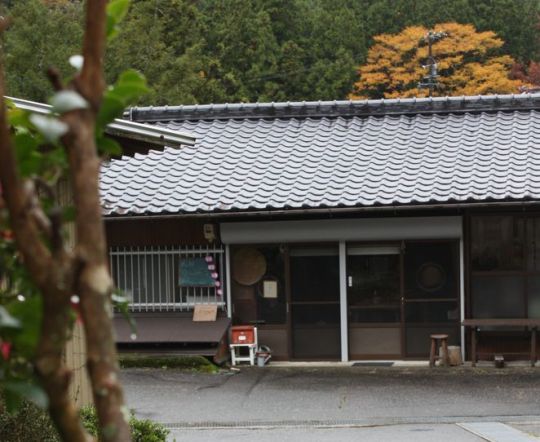
かっぱ亭
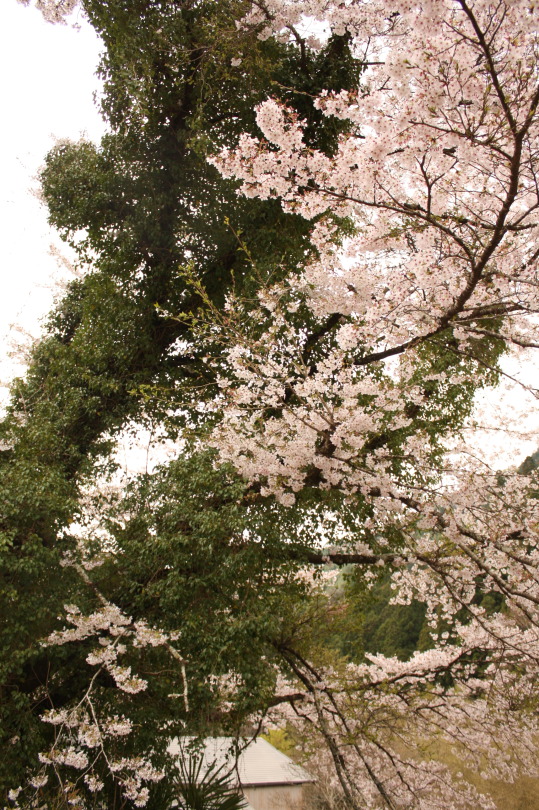

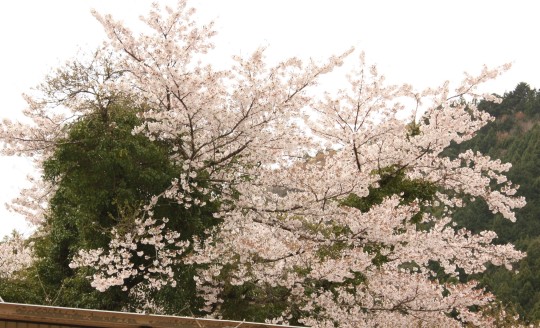
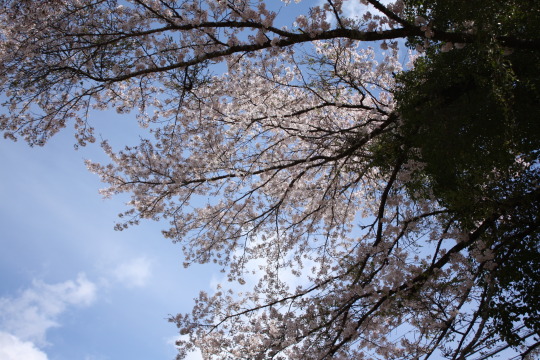
Recently every morning I make it a rule to go for a walk in order to see a sakura which I named 比翼連理の桜HIYOKURERNNRI NO SAKURA.
比翼連理 is very old phrase which we can find in Chinese poem called 長恨歌CHOGONKA. It is a long poem telling the story of emperor玄宗GENSO and his wife楊貴妃YOUKIHI. The emperor loved his wife so deeply, but loved too much. His attitude got his nation destabilized. The rebel army attacked the capital and 楊貴妃YOUKIHI was killed.
玄宗GENSO was left alone in deep grief, and remembered their promise. 'When we are in the sky, we are going to become a 比翼NOの鳥HIYOKU NO TORI’, ‘When we are on the ground we are going to become a 連理の枝RENRI NO EDA’.
'比翼の鳥HIYOKU NO TORI’ is a imaginary bird. Both male bird and female bird have only one eye and wing. So when they try to fly, they must make their bodies one and fly together.
連理の枝RENRI NO EDA is a word refers to two trees and their branches. Originally they were two trees. But branches fused and as a result of it the two became like one tree.
The word 比翼連理HIYOKURENRI is known as the word expressing a deep love of a couple in today’s Japan.
A sakura tree which I named 比翼連理の桜HIYOKURENRI NO SAKURA. This tree is pretty big and stands next to the national road in Mitsuhashi. But many drivers don’t see it even its flowers are in full bloom because those pink flowers are covered with green leaves. Approaching it on foot we can find thick vine creeping along the tree’s trunk. Its foliage covers whole tree and prevent drivers from finding the tree. The vine and the tree looks as if they were fused.
我が家から100mくらいのところに、私がひそかに「比翼連理の桜」と呼んでいる一風変わった桜の木があります。「比翼連理」といえば長恨歌にあるフレーズです。善政を行うのに疲れ果てた唐の玄宗皇帝は、美女楊貴妃を寵愛しますが、そのため国を揺るがす動乱が生じます。楊貴妃は戦乱の中で殺され、失意の玄宗は幸せだったころに二人で取り交わした約束を思い出すのです。
「天に在りては願わくは比翼の鳥と作らん、地に在りては連理の枝と為らん」
比翼の鳥とは、雌雄ともに一つ目・片翼しかない鳥で、飛ぶためには二羽が身を合わせる必要があります。連理の枝とは、二本の木のそれぞれの枝が融合して一本の木になったように見えるものを言います。転じて比翼連理とは夫婦や恋人の中が睦まじいことを言うのですね。
私が比翼連理の桜と呼ぶこの木は、まさに連理の枝なんです。国道のすぐわきになっているのに、花がみつかりづらい。なぜかといえば、絡みついた太い太いつる草が、桜の木をも、花をも、覆っているからです。近くに寄ってみるとわかるでしょう。つる草がすっかり木の幹と融合しているそのすがた。枝と枝ではありませんが、生き物が溶け合うその姿からは、人もかくあるべしという声が聞こえてきそうです。
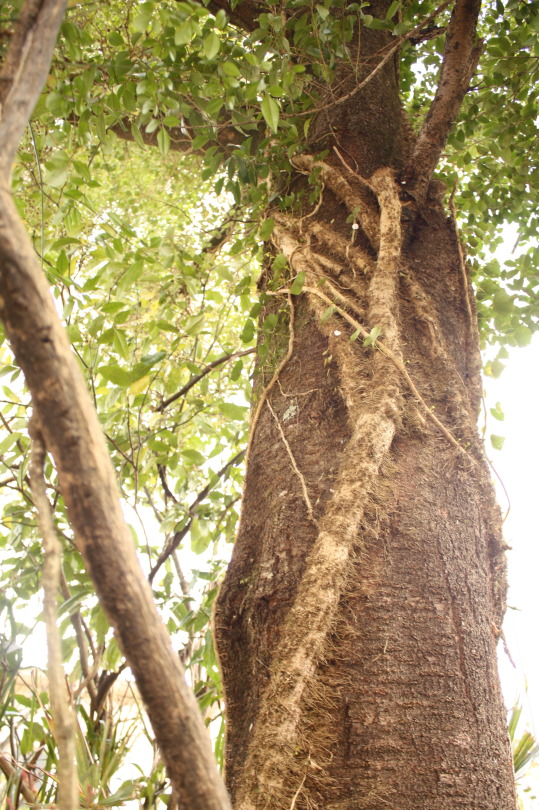
One day around KappaTei





